Literature Review: Division of Labour and its Organizational Impact
VerifiedAdded on 2021/01/01
|9
|2560
|352
Literature Review
AI Summary
This literature review examines the concept of the division of labor and its implications for organizational performance, particularly within the context of Marriott Hotel. The review begins with an introduction to the topic, defining literature review and its role in providing a comprehensive understanding of the subject. It then delves into the main body, exploring various aspects of the division of labor, including its advantages such as increased efficiency and productivity, and disadvantages like monotony and potential loss of responsibility. The review covers different forms of labor division like geographical, simple, complex, and occupational division. The discussion also highlights the relationship between division of labor and business performance, emphasizing its role in employee management, skills development, and the overall success of an organization. The review concludes by summarizing key findings and emphasizing the importance of effective labor distribution for building a well-structured workplace and achieving organizational goals. It stresses the need for businesses, like Marriott, to utilize their workforce effectively by assigning tasks based on skills and abilities.

Submission 2: Literature Review
Paraphrase This Document
Need a fresh take? Get an instant paraphrase of this document with our AI Paraphraser

Table of Contents
Submission 2: Literature Review ....................................................................................................1
CHAPTER 1 : LITERATURE REVIEW INTRODUCTION ........................................................1
CHAPTER 2 : LITERATURE REVIEW MAIN BODY................................................................1
Advantages of Division of Labour..............................................................................................3
CHAPTER 3 : LITERATURE CONCLUSION .............................................................................5
Submission 2: Literature Review ....................................................................................................1
CHAPTER 1 : LITERATURE REVIEW INTRODUCTION ........................................................1
CHAPTER 2 : LITERATURE REVIEW MAIN BODY................................................................1
Advantages of Division of Labour..............................................................................................3
CHAPTER 3 : LITERATURE CONCLUSION .............................................................................5
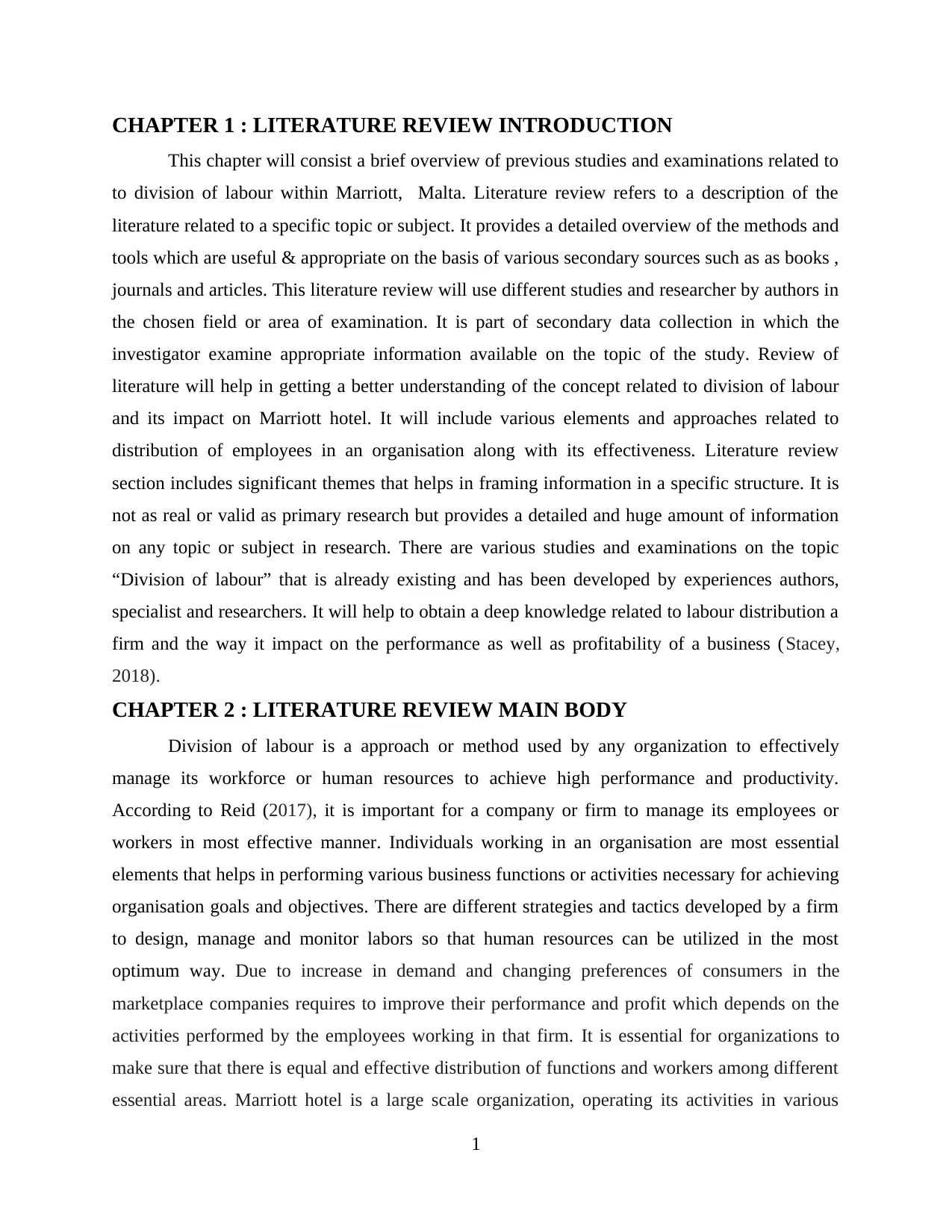
CHAPTER 1 : LITERATURE REVIEW INTRODUCTION
This chapter will consist a brief overview of previous studies and examinations related to
to division of labour within Marriott, Malta. Literature review refers to a description of the
literature related to a specific topic or subject. It provides a detailed overview of the methods and
tools which are useful & appropriate on the basis of various secondary sources such as as books ,
journals and articles. This literature review will use different studies and researcher by authors in
the chosen field or area of examination. It is part of secondary data collection in which the
investigator examine appropriate information available on the topic of the study. Review of
literature will help in getting a better understanding of the concept related to division of labour
and its impact on Marriott hotel. It will include various elements and approaches related to
distribution of employees in an organisation along with its effectiveness. Literature review
section includes significant themes that helps in framing information in a specific structure. It is
not as real or valid as primary research but provides a detailed and huge amount of information
on any topic or subject in research. There are various studies and examinations on the topic
“Division of labour” that is already existing and has been developed by experiences authors,
specialist and researchers. It will help to obtain a deep knowledge related to labour distribution a
firm and the way it impact on the performance as well as profitability of a business (Stacey,
2018).
CHAPTER 2 : LITERATURE REVIEW MAIN BODY
Division of labour is a approach or method used by any organization to effectively
manage its workforce or human resources to achieve high performance and productivity.
According to Reid (2017), it is important for a company or firm to manage its employees or
workers in most effective manner. Individuals working in an organisation are most essential
elements that helps in performing various business functions or activities necessary for achieving
organisation goals and objectives. There are different strategies and tactics developed by a firm
to design, manage and monitor labors so that human resources can be utilized in the most
optimum way. Due to increase in demand and changing preferences of consumers in the
marketplace companies requires to improve their performance and profit which depends on the
activities performed by the employees working in that firm. It is essential for organizations to
make sure that there is equal and effective distribution of functions and workers among different
essential areas. Marriott hotel is a large scale organization, operating its activities in various
1
This chapter will consist a brief overview of previous studies and examinations related to
to division of labour within Marriott, Malta. Literature review refers to a description of the
literature related to a specific topic or subject. It provides a detailed overview of the methods and
tools which are useful & appropriate on the basis of various secondary sources such as as books ,
journals and articles. This literature review will use different studies and researcher by authors in
the chosen field or area of examination. It is part of secondary data collection in which the
investigator examine appropriate information available on the topic of the study. Review of
literature will help in getting a better understanding of the concept related to division of labour
and its impact on Marriott hotel. It will include various elements and approaches related to
distribution of employees in an organisation along with its effectiveness. Literature review
section includes significant themes that helps in framing information in a specific structure. It is
not as real or valid as primary research but provides a detailed and huge amount of information
on any topic or subject in research. There are various studies and examinations on the topic
“Division of labour” that is already existing and has been developed by experiences authors,
specialist and researchers. It will help to obtain a deep knowledge related to labour distribution a
firm and the way it impact on the performance as well as profitability of a business (Stacey,
2018).
CHAPTER 2 : LITERATURE REVIEW MAIN BODY
Division of labour is a approach or method used by any organization to effectively
manage its workforce or human resources to achieve high performance and productivity.
According to Reid (2017), it is important for a company or firm to manage its employees or
workers in most effective manner. Individuals working in an organisation are most essential
elements that helps in performing various business functions or activities necessary for achieving
organisation goals and objectives. There are different strategies and tactics developed by a firm
to design, manage and monitor labors so that human resources can be utilized in the most
optimum way. Due to increase in demand and changing preferences of consumers in the
marketplace companies requires to improve their performance and profit which depends on the
activities performed by the employees working in that firm. It is essential for organizations to
make sure that there is equal and effective distribution of functions and workers among different
essential areas. Marriott hotel is a large scale organization, operating its activities in various
1
⊘ This is a preview!⊘
Do you want full access?
Subscribe today to unlock all pages.

Trusted by 1+ million students worldwide

countries. Organizational rules and regulations are needs to be very effective in managing
employees as there are a lot of issues raised with respect to workforce and these issues negatively
affect overall performance of a business. Durkheim (2018) stated that organizations having a
large scale of production or wide range of business operations such as in Marriott hotel, needs
special care for managing and distributing labour in every department or area of the firm.
Effective division of labour assist in improving every function and performing the activities
successfully in the best way possible. Human resource management plays an important role in
developing a potential workforce within every organisation, employees in a firm enters into it
through selection procedure created by HRM of the company(Kyatuha, Basheka and Ziwa,
2017). It is an important responsibility of the HR managers to recruit most skilled and capable
candidates so that they can contribute in the growth and development of organisation. In
addition to this human resource management is also responsible for managing the employees,
conducting training programs for them, providing motivational elements to boost their
performance as well as resolve any issues they faces while working in the organisation.
According to Contzen and Forney(2017) a single employee is not responsible for producing a
product or delivering a service to satisfy the needs of customers, there is a contribution of each
and every individual working in a firm or business. Therefore, it is important to consider that it
should not be concerned what the designation of a employees is, he or she is significant for the
organization and assist in achieving goals of the company. On the other hand The work and
performance of company become specialized with proper division of labour For economic
system of company, labour division strategies is very crucial. Division of labor can be referred
as a essential instrument for growth and development of an organisation or business. This
concept came to into existence since the development of human beings, man and women adopted
their functions known to them or according to the nature of work. It is the main element of
concept related to distribution or division of labour which states that production process or
operations of a company is divided into wide range of individual practices and each activity is
referred to a specific task which is necessary to be performed by a single worker or employee.
Distribution of labour was first developed from the division of employees in different
occupations and departments but due to development of large scale production and increased
business activities, the operations of an organisation has been divided into various activities and
2
employees as there are a lot of issues raised with respect to workforce and these issues negatively
affect overall performance of a business. Durkheim (2018) stated that organizations having a
large scale of production or wide range of business operations such as in Marriott hotel, needs
special care for managing and distributing labour in every department or area of the firm.
Effective division of labour assist in improving every function and performing the activities
successfully in the best way possible. Human resource management plays an important role in
developing a potential workforce within every organisation, employees in a firm enters into it
through selection procedure created by HRM of the company(Kyatuha, Basheka and Ziwa,
2017). It is an important responsibility of the HR managers to recruit most skilled and capable
candidates so that they can contribute in the growth and development of organisation. In
addition to this human resource management is also responsible for managing the employees,
conducting training programs for them, providing motivational elements to boost their
performance as well as resolve any issues they faces while working in the organisation.
According to Contzen and Forney(2017) a single employee is not responsible for producing a
product or delivering a service to satisfy the needs of customers, there is a contribution of each
and every individual working in a firm or business. Therefore, it is important to consider that it
should not be concerned what the designation of a employees is, he or she is significant for the
organization and assist in achieving goals of the company. On the other hand The work and
performance of company become specialized with proper division of labour For economic
system of company, labour division strategies is very crucial. Division of labor can be referred
as a essential instrument for growth and development of an organisation or business. This
concept came to into existence since the development of human beings, man and women adopted
their functions known to them or according to the nature of work. It is the main element of
concept related to distribution or division of labour which states that production process or
operations of a company is divided into wide range of individual practices and each activity is
referred to a specific task which is necessary to be performed by a single worker or employee.
Distribution of labour was first developed from the division of employees in different
occupations and departments but due to development of large scale production and increased
business activities, the operations of an organisation has been divided into various activities and
2
Paraphrase This Document
Need a fresh take? Get an instant paraphrase of this document with our AI Paraphraser
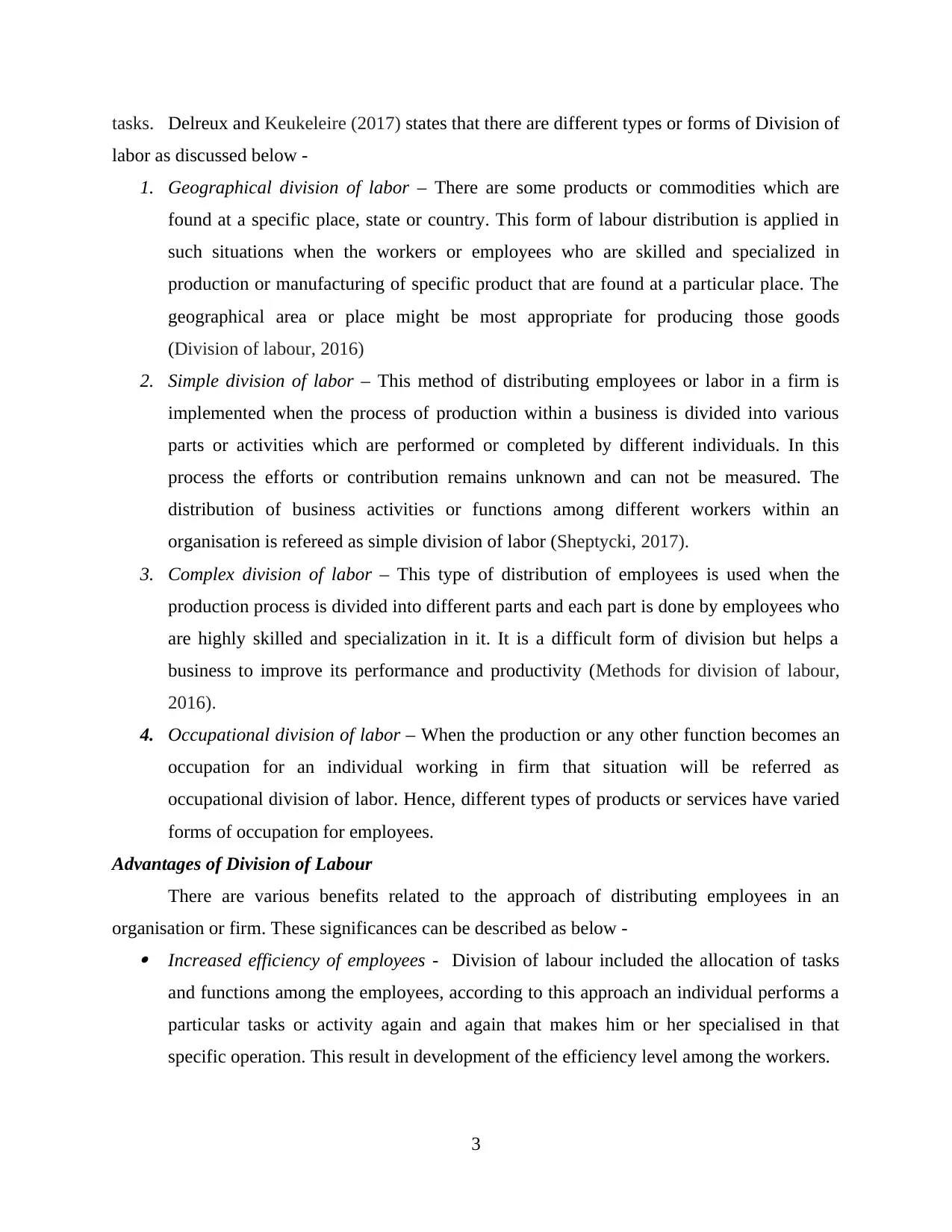
tasks. Delreux and Keukeleire (2017) states that there are different types or forms of Division of
labor as discussed below -
1. Geographical division of labor – There are some products or commodities which are
found at a specific place, state or country. This form of labour distribution is applied in
such situations when the workers or employees who are skilled and specialized in
production or manufacturing of specific product that are found at a particular place. The
geographical area or place might be most appropriate for producing those goods
(Division of labour, 2016)
2. Simple division of labor – This method of distributing employees or labor in a firm is
implemented when the process of production within a business is divided into various
parts or activities which are performed or completed by different individuals. In this
process the efforts or contribution remains unknown and can not be measured. The
distribution of business activities or functions among different workers within an
organisation is refereed as simple division of labor (Sheptycki, 2017).
3. Complex division of labor – This type of distribution of employees is used when the
production process is divided into different parts and each part is done by employees who
are highly skilled and specialization in it. It is a difficult form of division but helps a
business to improve its performance and productivity (Methods for division of labour,
2016).
4. Occupational division of labor – When the production or any other function becomes an
occupation for an individual working in firm that situation will be referred as
occupational division of labor. Hence, different types of products or services have varied
forms of occupation for employees.
Advantages of Division of Labour
There are various benefits related to the approach of distributing employees in an
organisation or firm. These significances can be described as below - Increased efficiency of employees - Division of labour included the allocation of tasks
and functions among the employees, according to this approach an individual performs a
particular tasks or activity again and again that makes him or her specialised in that
specific operation. This result in development of the efficiency level among the workers.
3
labor as discussed below -
1. Geographical division of labor – There are some products or commodities which are
found at a specific place, state or country. This form of labour distribution is applied in
such situations when the workers or employees who are skilled and specialized in
production or manufacturing of specific product that are found at a particular place. The
geographical area or place might be most appropriate for producing those goods
(Division of labour, 2016)
2. Simple division of labor – This method of distributing employees or labor in a firm is
implemented when the process of production within a business is divided into various
parts or activities which are performed or completed by different individuals. In this
process the efforts or contribution remains unknown and can not be measured. The
distribution of business activities or functions among different workers within an
organisation is refereed as simple division of labor (Sheptycki, 2017).
3. Complex division of labor – This type of distribution of employees is used when the
production process is divided into different parts and each part is done by employees who
are highly skilled and specialization in it. It is a difficult form of division but helps a
business to improve its performance and productivity (Methods for division of labour,
2016).
4. Occupational division of labor – When the production or any other function becomes an
occupation for an individual working in firm that situation will be referred as
occupational division of labor. Hence, different types of products or services have varied
forms of occupation for employees.
Advantages of Division of Labour
There are various benefits related to the approach of distributing employees in an
organisation or firm. These significances can be described as below - Increased efficiency of employees - Division of labour included the allocation of tasks
and functions among the employees, according to this approach an individual performs a
particular tasks or activity again and again that makes him or her specialised in that
specific operation. This result in development of the efficiency level among the workers.
3
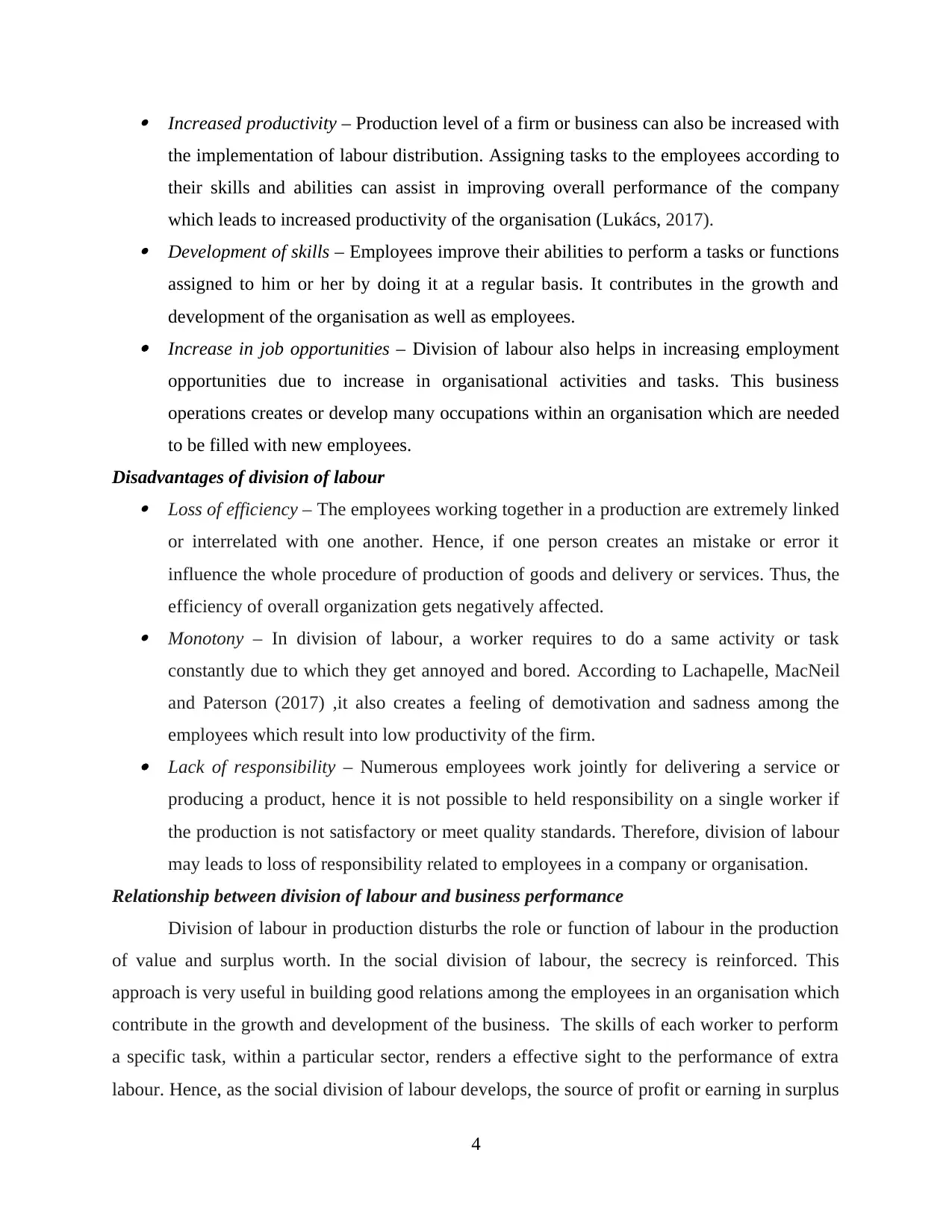
Increased productivity – Production level of a firm or business can also be increased with
the implementation of labour distribution. Assigning tasks to the employees according to
their skills and abilities can assist in improving overall performance of the company
which leads to increased productivity of the organisation (Lukács, 2017). Development of skills – Employees improve their abilities to perform a tasks or functions
assigned to him or her by doing it at a regular basis. It contributes in the growth and
development of the organisation as well as employees. Increase in job opportunities – Division of labour also helps in increasing employment
opportunities due to increase in organisational activities and tasks. This business
operations creates or develop many occupations within an organisation which are needed
to be filled with new employees.
Disadvantages of division of labour Loss of efficiency – The employees working together in a production are extremely linked
or interrelated with one another. Hence, if one person creates an mistake or error it
influence the whole procedure of production of goods and delivery or services. Thus, the
efficiency of overall organization gets negatively affected. Monotony – In division of labour, a worker requires to do a same activity or task
constantly due to which they get annoyed and bored. According to Lachapelle, MacNeil
and Paterson (2017) ,it also creates a feeling of demotivation and sadness among the
employees which result into low productivity of the firm. Lack of responsibility – Numerous employees work jointly for delivering a service or
producing a product, hence it is not possible to held responsibility on a single worker if
the production is not satisfactory or meet quality standards. Therefore, division of labour
may leads to loss of responsibility related to employees in a company or organisation.
Relationship between division of labour and business performance
Division of labour in production disturbs the role or function of labour in the production
of value and surplus worth. In the social division of labour, the secrecy is reinforced. This
approach is very useful in building good relations among the employees in an organisation which
contribute in the growth and development of the business. The skills of each worker to perform
a specific task, within a particular sector, renders a effective sight to the performance of extra
labour. Hence, as the social division of labour develops, the source of profit or earning in surplus
4
the implementation of labour distribution. Assigning tasks to the employees according to
their skills and abilities can assist in improving overall performance of the company
which leads to increased productivity of the organisation (Lukács, 2017). Development of skills – Employees improve their abilities to perform a tasks or functions
assigned to him or her by doing it at a regular basis. It contributes in the growth and
development of the organisation as well as employees. Increase in job opportunities – Division of labour also helps in increasing employment
opportunities due to increase in organisational activities and tasks. This business
operations creates or develop many occupations within an organisation which are needed
to be filled with new employees.
Disadvantages of division of labour Loss of efficiency – The employees working together in a production are extremely linked
or interrelated with one another. Hence, if one person creates an mistake or error it
influence the whole procedure of production of goods and delivery or services. Thus, the
efficiency of overall organization gets negatively affected. Monotony – In division of labour, a worker requires to do a same activity or task
constantly due to which they get annoyed and bored. According to Lachapelle, MacNeil
and Paterson (2017) ,it also creates a feeling of demotivation and sadness among the
employees which result into low productivity of the firm. Lack of responsibility – Numerous employees work jointly for delivering a service or
producing a product, hence it is not possible to held responsibility on a single worker if
the production is not satisfactory or meet quality standards. Therefore, division of labour
may leads to loss of responsibility related to employees in a company or organisation.
Relationship between division of labour and business performance
Division of labour in production disturbs the role or function of labour in the production
of value and surplus worth. In the social division of labour, the secrecy is reinforced. This
approach is very useful in building good relations among the employees in an organisation which
contribute in the growth and development of the business. The skills of each worker to perform
a specific task, within a particular sector, renders a effective sight to the performance of extra
labour. Hence, as the social division of labour develops, the source of profit or earning in surplus
4
⊘ This is a preview!⊘
Do you want full access?
Subscribe today to unlock all pages.

Trusted by 1+ million students worldwide
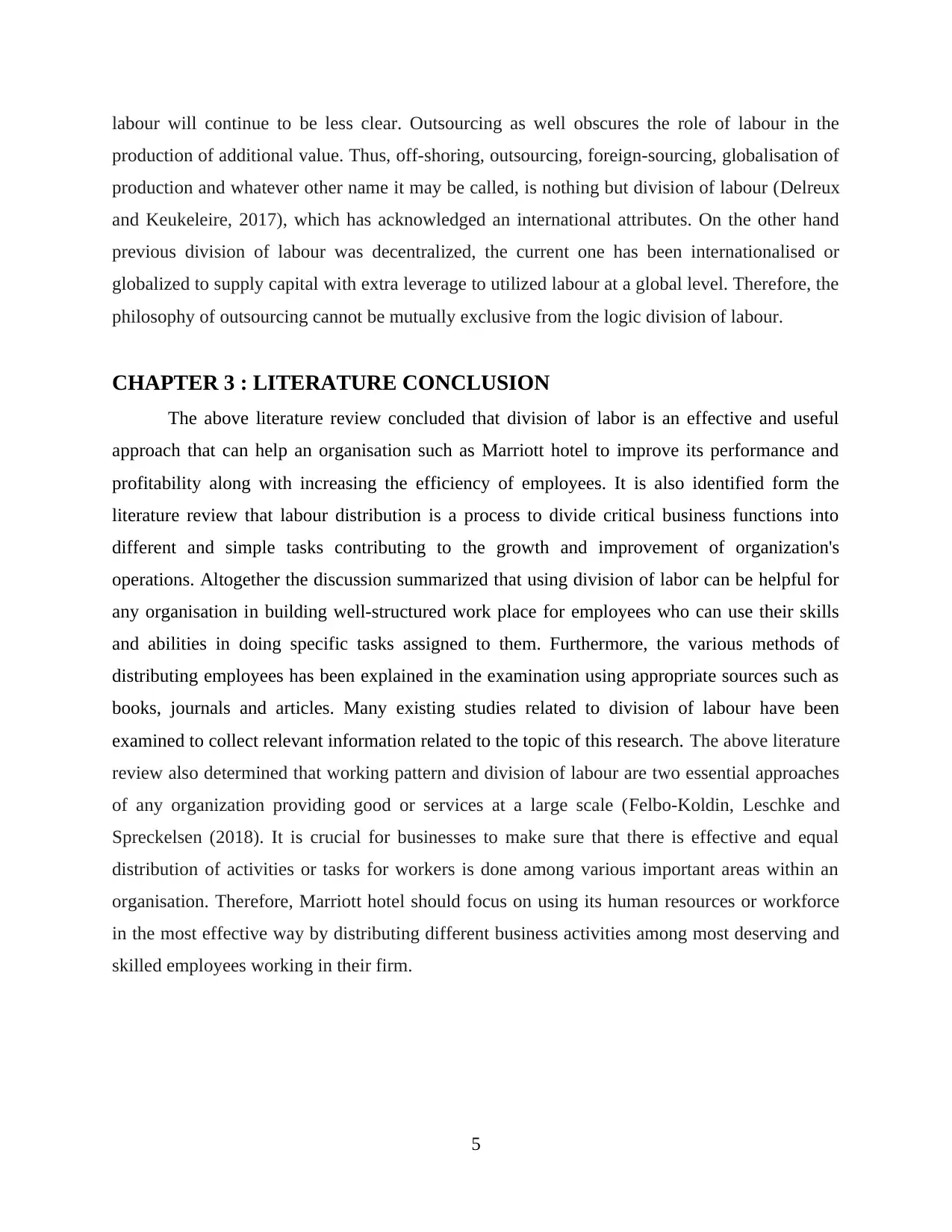
labour will continue to be less clear. Outsourcing as well obscures the role of labour in the
production of additional value. Thus, off-shoring, outsourcing, foreign-sourcing, globalisation of
production and whatever other name it may be called, is nothing but division of labour (Delreux
and Keukeleire, 2017), which has acknowledged an international attributes. On the other hand
previous division of labour was decentralized, the current one has been internationalised or
globalized to supply capital with extra leverage to utilized labour at a global level. Therefore, the
philosophy of outsourcing cannot be mutually exclusive from the logic division of labour.
CHAPTER 3 : LITERATURE CONCLUSION
The above literature review concluded that division of labor is an effective and useful
approach that can help an organisation such as Marriott hotel to improve its performance and
profitability along with increasing the efficiency of employees. It is also identified form the
literature review that labour distribution is a process to divide critical business functions into
different and simple tasks contributing to the growth and improvement of organization's
operations. Altogether the discussion summarized that using division of labor can be helpful for
any organisation in building well-structured work place for employees who can use their skills
and abilities in doing specific tasks assigned to them. Furthermore, the various methods of
distributing employees has been explained in the examination using appropriate sources such as
books, journals and articles. Many existing studies related to division of labour have been
examined to collect relevant information related to the topic of this research. The above literature
review also determined that working pattern and division of labour are two essential approaches
of any organization providing good or services at a large scale (Felbo-Koldin, Leschke and
Spreckelsen (2018). It is crucial for businesses to make sure that there is effective and equal
distribution of activities or tasks for workers is done among various important areas within an
organisation. Therefore, Marriott hotel should focus on using its human resources or workforce
in the most effective way by distributing different business activities among most deserving and
skilled employees working in their firm.
5
production of additional value. Thus, off-shoring, outsourcing, foreign-sourcing, globalisation of
production and whatever other name it may be called, is nothing but division of labour (Delreux
and Keukeleire, 2017), which has acknowledged an international attributes. On the other hand
previous division of labour was decentralized, the current one has been internationalised or
globalized to supply capital with extra leverage to utilized labour at a global level. Therefore, the
philosophy of outsourcing cannot be mutually exclusive from the logic division of labour.
CHAPTER 3 : LITERATURE CONCLUSION
The above literature review concluded that division of labor is an effective and useful
approach that can help an organisation such as Marriott hotel to improve its performance and
profitability along with increasing the efficiency of employees. It is also identified form the
literature review that labour distribution is a process to divide critical business functions into
different and simple tasks contributing to the growth and improvement of organization's
operations. Altogether the discussion summarized that using division of labor can be helpful for
any organisation in building well-structured work place for employees who can use their skills
and abilities in doing specific tasks assigned to them. Furthermore, the various methods of
distributing employees has been explained in the examination using appropriate sources such as
books, journals and articles. Many existing studies related to division of labour have been
examined to collect relevant information related to the topic of this research. The above literature
review also determined that working pattern and division of labour are two essential approaches
of any organization providing good or services at a large scale (Felbo-Koldin, Leschke and
Spreckelsen (2018). It is crucial for businesses to make sure that there is effective and equal
distribution of activities or tasks for workers is done among various important areas within an
organisation. Therefore, Marriott hotel should focus on using its human resources or workforce
in the most effective way by distributing different business activities among most deserving and
skilled employees working in their firm.
5
Paraphrase This Document
Need a fresh take? Get an instant paraphrase of this document with our AI Paraphraser
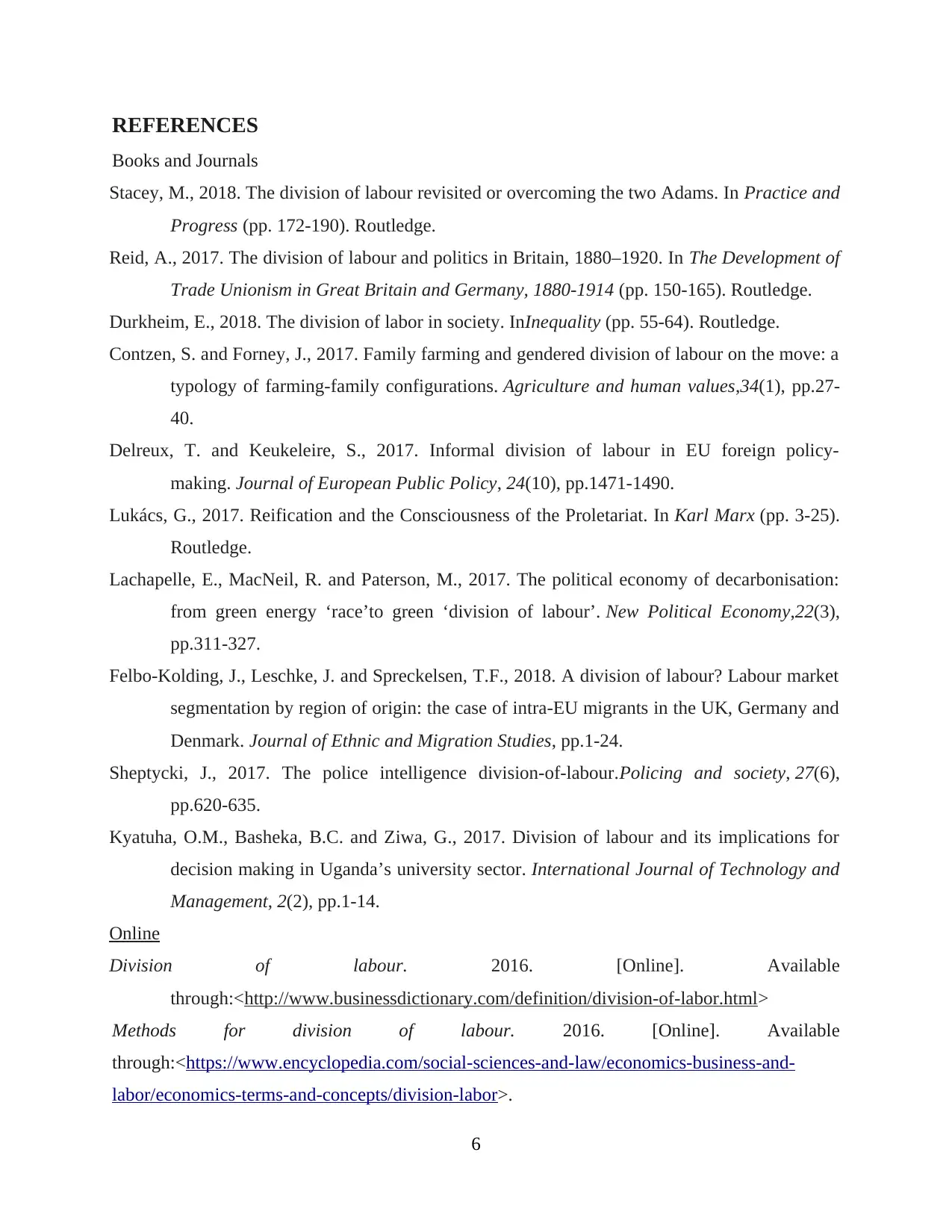
REFERENCES
Books and Journals
Stacey, M., 2018. The division of labour revisited or overcoming the two Adams. In Practice and
Progress (pp. 172-190). Routledge.
Reid, A., 2017. The division of labour and politics in Britain, 1880–1920. In The Development of
Trade Unionism in Great Britain and Germany, 1880-1914 (pp. 150-165). Routledge.
Durkheim, E., 2018. The division of labor in society. InInequality (pp. 55-64). Routledge.
Contzen, S. and Forney, J., 2017. Family farming and gendered division of labour on the move: a
typology of farming-family configurations. Agriculture and human values,34(1), pp.27-
40.
Delreux, T. and Keukeleire, S., 2017. Informal division of labour in EU foreign policy-
making. Journal of European Public Policy, 24(10), pp.1471-1490.
Lukács, G., 2017. Reification and the Consciousness of the Proletariat. In Karl Marx (pp. 3-25).
Routledge.
Lachapelle, E., MacNeil, R. and Paterson, M., 2017. The political economy of decarbonisation:
from green energy ‘race’to green ‘division of labour’. New Political Economy,22(3),
pp.311-327.
Felbo-Kolding, J., Leschke, J. and Spreckelsen, T.F., 2018. A division of labour? Labour market
segmentation by region of origin: the case of intra-EU migrants in the UK, Germany and
Denmark. Journal of Ethnic and Migration Studies, pp.1-24.
Sheptycki, J., 2017. The police intelligence division-of-labour.Policing and society, 27(6),
pp.620-635.
Kyatuha, O.M., Basheka, B.C. and Ziwa, G., 2017. Division of labour and its implications for
decision making in Uganda’s university sector. International Journal of Technology and
Management, 2(2), pp.1-14.
Online
Division of labour. 2016. [Online]. Available
through:<http://www.businessdictionary.com/definition/division-of-labor.html>
Methods for division of labour. 2016. [Online]. Available
through:<https://www.encyclopedia.com/social-sciences-and-law/economics-business-and-
labor/economics-terms-and-concepts/division-labor>.
6
Books and Journals
Stacey, M., 2018. The division of labour revisited or overcoming the two Adams. In Practice and
Progress (pp. 172-190). Routledge.
Reid, A., 2017. The division of labour and politics in Britain, 1880–1920. In The Development of
Trade Unionism in Great Britain and Germany, 1880-1914 (pp. 150-165). Routledge.
Durkheim, E., 2018. The division of labor in society. InInequality (pp. 55-64). Routledge.
Contzen, S. and Forney, J., 2017. Family farming and gendered division of labour on the move: a
typology of farming-family configurations. Agriculture and human values,34(1), pp.27-
40.
Delreux, T. and Keukeleire, S., 2017. Informal division of labour in EU foreign policy-
making. Journal of European Public Policy, 24(10), pp.1471-1490.
Lukács, G., 2017. Reification and the Consciousness of the Proletariat. In Karl Marx (pp. 3-25).
Routledge.
Lachapelle, E., MacNeil, R. and Paterson, M., 2017. The political economy of decarbonisation:
from green energy ‘race’to green ‘division of labour’. New Political Economy,22(3),
pp.311-327.
Felbo-Kolding, J., Leschke, J. and Spreckelsen, T.F., 2018. A division of labour? Labour market
segmentation by region of origin: the case of intra-EU migrants in the UK, Germany and
Denmark. Journal of Ethnic and Migration Studies, pp.1-24.
Sheptycki, J., 2017. The police intelligence division-of-labour.Policing and society, 27(6),
pp.620-635.
Kyatuha, O.M., Basheka, B.C. and Ziwa, G., 2017. Division of labour and its implications for
decision making in Uganda’s university sector. International Journal of Technology and
Management, 2(2), pp.1-14.
Online
Division of labour. 2016. [Online]. Available
through:<http://www.businessdictionary.com/definition/division-of-labor.html>
Methods for division of labour. 2016. [Online]. Available
through:<https://www.encyclopedia.com/social-sciences-and-law/economics-business-and-
labor/economics-terms-and-concepts/division-labor>.
6

7
⊘ This is a preview!⊘
Do you want full access?
Subscribe today to unlock all pages.

Trusted by 1+ million students worldwide
1 out of 9
Related Documents
Your All-in-One AI-Powered Toolkit for Academic Success.
+13062052269
info@desklib.com
Available 24*7 on WhatsApp / Email
![[object Object]](/_next/static/media/star-bottom.7253800d.svg)
Unlock your academic potential
Copyright © 2020–2025 A2Z Services. All Rights Reserved. Developed and managed by ZUCOL.





